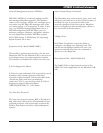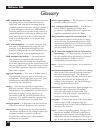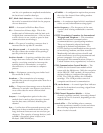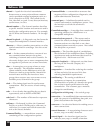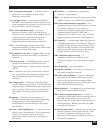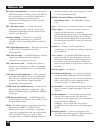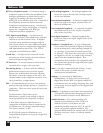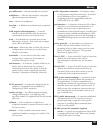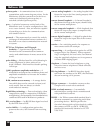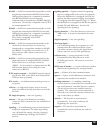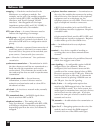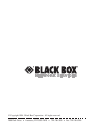
Glossary
261
RS-422 — An EIA-recommended standard for cable
lengths that extended the RS-232 50-foot limit.
Although introduced as a companion standard
with RS-449, RS-422 is most frequently
implemented on unused pins of DB25 (RS-232)
connectors. Electrically compatible with CCITT
recommendation V.11.
RS-423 — An EIA-recommended standard for cable
lengths that extended the RS-232 50 foot limit.
Although introduced as a companion standard
with RS-422, RS-423 is not widely used.
Electrically compatible with CCITT
recommendation V.10.
RS-449 — An EIA-recommended standard for the
mechanical characteristics of connectors;
introduced as a companion standard to RS-422
and RS-423. It specifies two connectors (a 37-
pin connector and a 9-pin connector); not
widely used.
RS-530 — An EIA-recommended standard for the
implementation of standard RS-422 or RS-423
Driver/Receivers on a 25-pin connector
(DB25). It is intended as a replacement for RS-
449 for most data services using the same
connector as RS-232.
RTS, request-to-send — An RS-232 interface signal,
sent from a DTE to the DCE, that indicates the
DTE has data to transmit.
RX, receive — An abbreviation meaning receive or
reception.
self-test — A diagnostic feature used to test the
voice/fax channel locally that does not include
the link.
SF, single frequency — See tone signaling.
shroud — The part of a Multiserver stacking
connector that is mounted on the underside of
a module.
signaling — A handshaking protocol used between
telephone equipment. Includes supervising
(on/off hook line status), alerting (ringing),
and call addressing (dialing) for switched
services.
signaling options — Options related to signaling
that are configurable in the voice/fax module.
When the Multiserver is strapped for KTS, the
options include repeated ringing, interrupted
2/4 ringing, and interrupted 2 ring 1/2. When
the Multiserver is strapped for E&M, the options
include DC and 2280 tone. See also DC
signaling and tone signaling.
sign-on character — The first character sent on an
ABR circuit. It is used to determine the data
rate.
single frequency — See tone-signalling.
slow busy signal —
• In a switching mode, the response to a call
attempt when the called extension is busy.
• In a force-connect mode, the signal heard
when a sync loss occurs (link goes down).
software reset — A reset performed in the
Command Facility Main Menu or in the
LCD/Keypad menu. This may be a warm or
cold start.
SOH, start of header — A control character used to
indicate the beginning of a message header.
space — A binary 0 in data communications.
spacer — A piece of the Multiserver hardware that
separates one module from another.
stacking connector — A coupling containing
electrical pins or sockets that are located on the
top and bottom of a module board to connect
electrical wires from one module board to
another. The connector on the underside is
referred to as a shroud, and the connector on
top is referred to as a block.
start bit — The first bit in asynchronous
transmission. It is used to indicate the
beginning of a character.
stop bit — The last bit in asynchronous
transmission, used to indicate the end of a
character.



